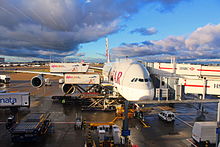Baggage handling system


A baggage handling system (BHS) is a type of conveyor system installed in airports that transports checked luggage from ticket counters to areas where the bags can be loaded onto airplanes. A BHS also transports checked baggage coming from airplanes to baggage claims or to an area where the bag can be loaded onto another airplane.
History[]
The first automated baggage handling system was invented by BNP Associates in 1971, and this technology is in use in almost every major airport worldwide today.[1]
Process[]
A bag is entered into the baggage handling system when an airline agent, or self check system, assign the luggage a tag with a unique ten digit barcode.[2] Airlines are also incorporating RFID chips into the tags to track bags in real time and to reduce the number of mishandled bags.[3] The BHS will then scan and sort the bags by airline. Then a series of diverters along the conveyor belt will direct the bags into the baggage handling area.[4]
Although the primary function of a BHS is the transportation of bags, a typical BHS will serve other functions involved in making sure that a bag gets to the correct location in the airport.
In addition to sortation, a BHS may also perform the following functions:
- Detection of bag jams
- Volume regulation (to ensure that input points are controlled to avoid overloading the system)
- Load balancing (to evenly distribute bag volume between conveyor sub-systems)
- Bag counting
- Bag tracking
- Automatic Tag Reader (ATR) (Reads the tags on the luggage provided by the airlines)
Security[]
Post September 11, 2001, the majority of airports around the world began to implement baggage screening directly into BHS systems. These systems are referred to as "Checked Baggage Inspection System" by the Transportation Security Administration (TSA) in the US, where bags are fed directly into Explosive Detection System (EDS) machines.[4] A CBIS can sort baggage based on each bag's security status assigned by an EDS machine or by a security screening operator.
References[]
- ^ "Baggage Handling". www.bnpassociates.com. Archived from the original on March 29, 2019. Retrieved March 29, 2019.
- ^ Nice, Karim (2001-06-13). "How Baggage Handling Works". HowStuffWorks. Retrieved March 25, 2019.
- ^ "The technology transforming baggage handling". Airport Technology. 2017-07-09. Retrieved March 25, 2019.
- ^ a b Baskas, Harriet (April 4, 2018). "The trip your luggage takes without you". USA TODAY. Retrieved March 25, 2019.
External links[]
- Aircraft ground handling
- Air freight
- Luggage